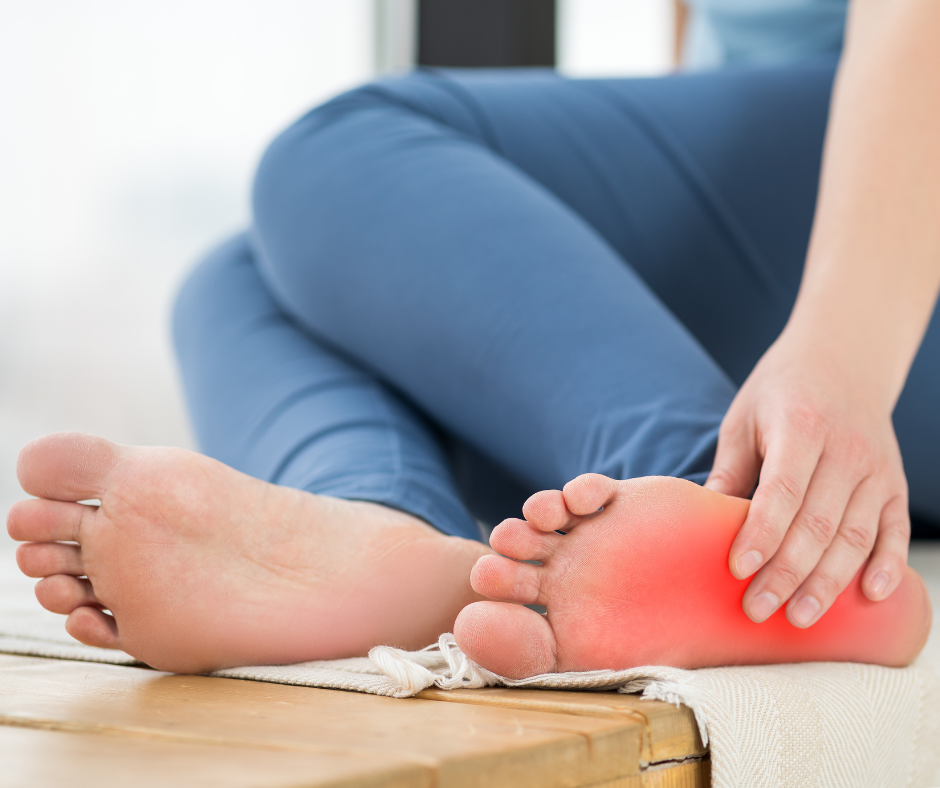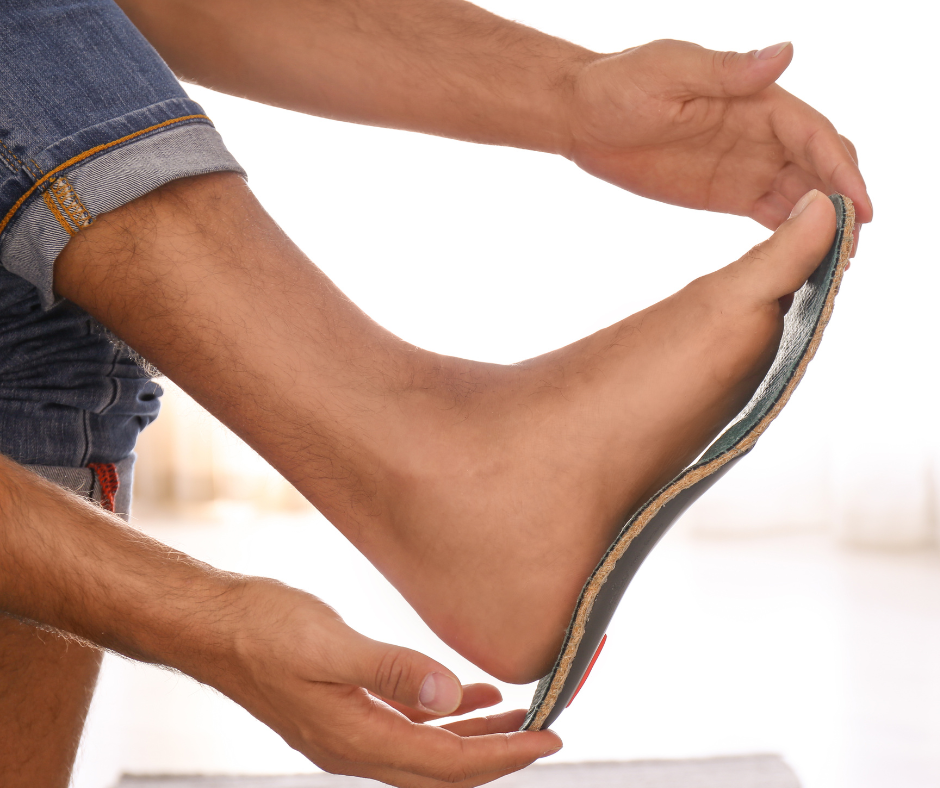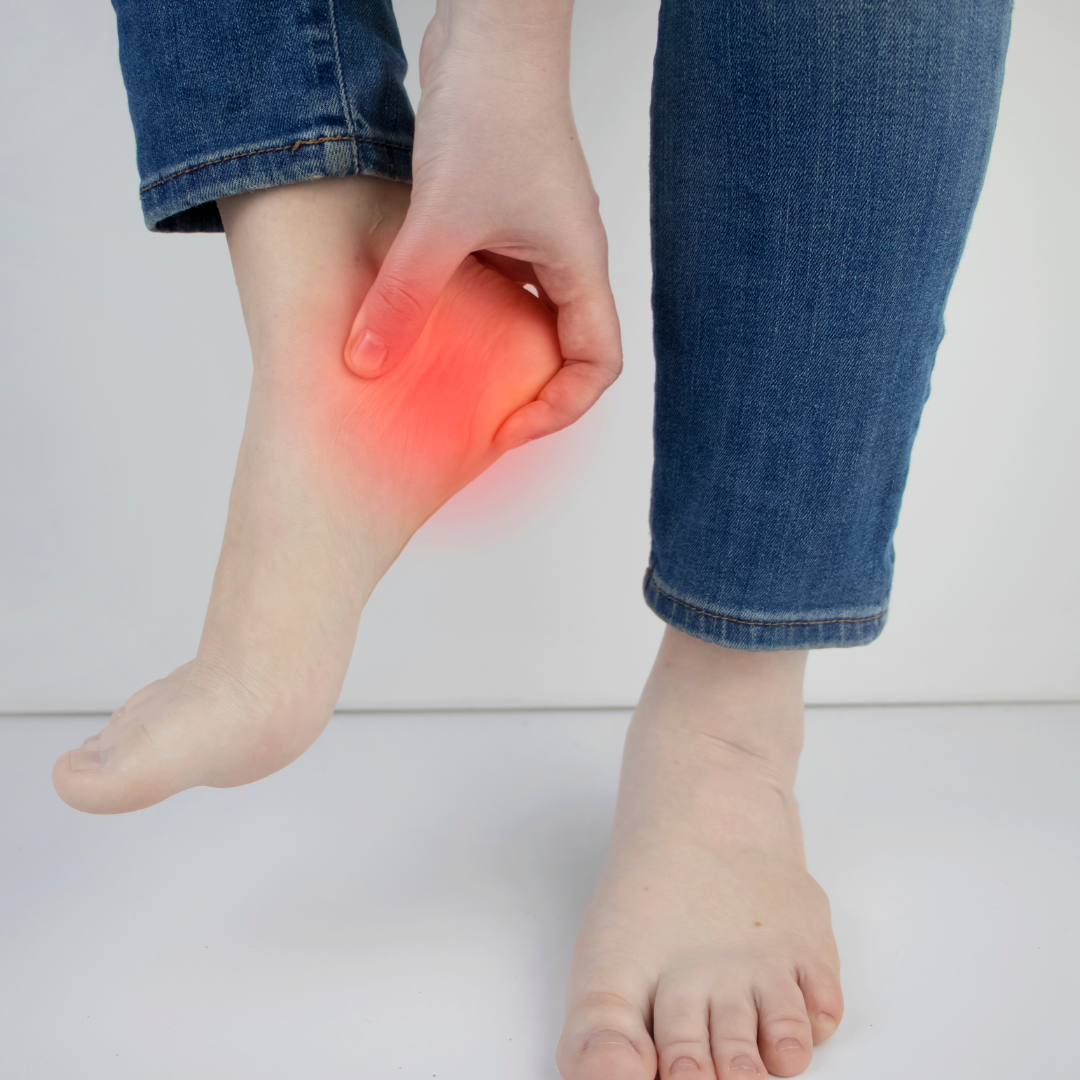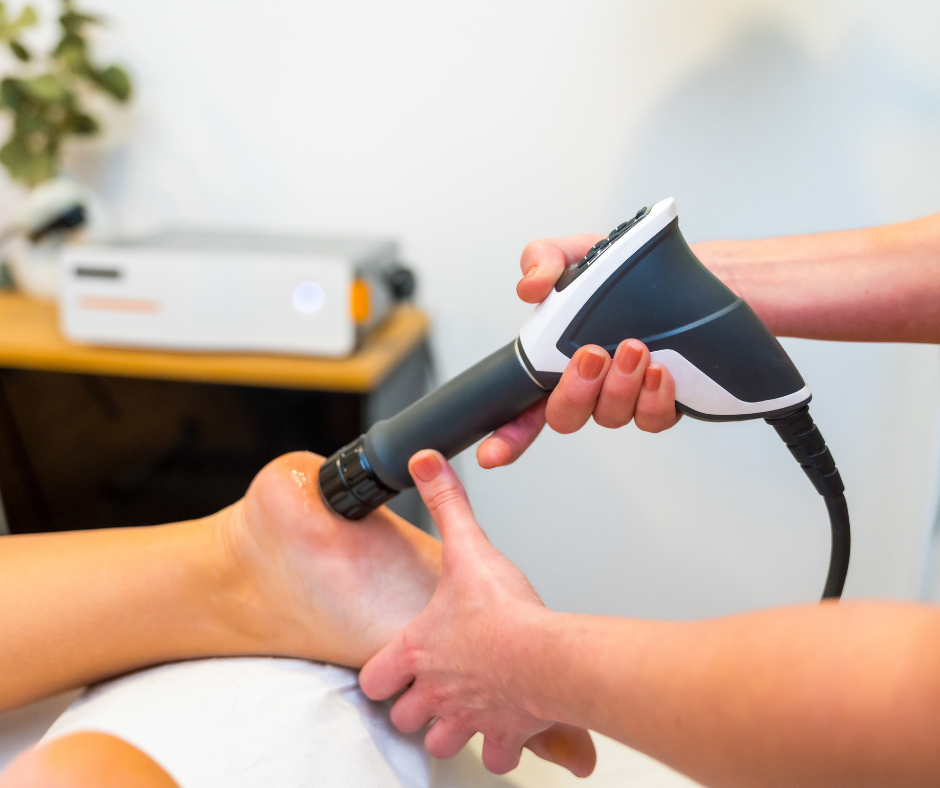-
A Podiatrist’s Guide to Plantar Fasciitis

You can’t fix a problem if you don’t even know what it is! That’s often the issue with plantar fasciitis, a common form of chronic heel pain that could affect up to 10% of the population! This time around, Kentlands Foot & Ankle Center will be explaining what defines the condition and which non-invasive treatment options you can trust.
Q: What exactly is plantar fasciitis?
A: Plantar fasciitis is the inflammation of the plantar fascia, a thick band of tissue running along the bottom of your foot, connecting your heel bone to your toes. Think of it as your foot’s built-in shock absorber. When it’s overstressed, it becomes painful.
Q: What does it feel like?
A: The hallmark symptom is stabbing heel pain, especially in the morning or after rest. It often feels better as you move around, then worsens again after activity. Some describe it as a deep ache or burning sensation along the arch.
Q: What causes it?
A: Several factors can contribute:
- Foot Mechanics: Flat feet, high arches, or abnormal walking patterns put extra strain on the plantar fascia.
- Overuse: Runners, walkers, and those who stand for long periods are at higher risk.
- Improper Footwear: Lack of arch support and cushioning.
- Tight Calf Muscles: Limit ankle flexibility, increasing stress on the fascia.
- Obesity: Excess weight adds pressure.
Q: How is it diagnosed?
A: A podiatrist can usually diagnose plantar fasciitis with a physical exam and review of your symptoms. X-rays may be needed to rule out other issues like stress fractures.
Q: How can I fix this without surgery?
A: Good news! About 95% of plantar fasciitis cases improve with non-surgical methods. Here are some key approaches:
- Rest: Reduce activities that aggravate the pain.
- Ice: Apply ice packs or roll a frozen water bottle under your foot for 15-20 minutes, 3-4 times a day.
- Stretching: Gentle stretches for your plantar fascia, Achilles tendon, and calf muscles are crucial.
- Supportive Shoes and Orthotics: Proper arch support and cushioning can redistribute pressure. Custom orthotics are often beneficial.
- Night Splints: These keep your foot flexed while you sleep, stretching the plantar fascia.
- Medications: Over-the-counter pain relievers (NSAIDs) can help with inflammation.
- Physical Therapy: A physical therapist can guide you through stretches, strengthening exercises, and other treatments.
Keep an eye out for future posts and more detailed information on treatments! We’ll explore options like ESWT, which involves using sound waves to stimulate healing in the plantar fascia.
Interested in learning more? We’re always happy to help! Schedule a comprehensive foot examination with Kentlands Foot and Ankle Center podiatrist Dr. Jon M. Sherman. To make your appointment, please call our office at 301-825-9697.
-
ESWT Shockwave Therapy Offers a New Approach
Chronic heel pain can make everyday activities like walking and standing unbearable, and while traditional treatments like stretching, orthotics, or injections might provide some relief, they can sometimes fall short.
Enter ESWT (Extracorporeal Shock Wave Therapy), a non-invasive alternative that’s changing the game for heel pain sufferers! Kentlands Foot & Ankle Center is always at the forefront of innovative, non-invasive options, and for this blog post, we’re going to cover all the ins and outs of this exciting option, including why it might be the right choice for you.
The Limitations of Traditional Approaches
Traditional treatments for heel pain, such as physical therapy and the use of orthotics, can be helpful in the initial stages.
- However, they often provide only temporary relief and may not address the underlying cause of the pain.
- In some cases, these treatments can be time-consuming, require a long recovery period, or have unwanted side effects.
ESWT: A Non-Invasive Solution
ESWT is a treatment that utilizes pressure waves to stimulate healing and reduce pain and inflammation. Unlike traditional surgery, ESWT doesn’t involve incisions, anesthesia, or a lengthy recovery period. It also boasts high success rates that are clinically verified.
How ESWT Works
ESWT targets the affected tissue with high-energy pressure waves, stimulating a healing response and promoting tissue regeneration.
- This can be particularly effective for conditions like plantar fasciitis, where the plantar fascia, the thick band of tissue along the bottom of the foot, becomes inflamed.
Shockwave Therapy vs. Traditional Surgery
- No Cutting: ESWT avoids the need for incisions, reducing the risk of complications associated with surgery.
- Faster Healing: Recovery from ESWT is significantly faster. For example, traditional heel spur surgery might require between six weeks and three months for a full recovery.
- Reduced Risk: ESWT eliminates the risk of permanent nerve or joint damage associated with some surgical procedures.
- Minimal Downtime: Patients can typically return to work and daily activities much sooner after ESWT compared to surgery.
- Less Pain: ESWT generally involves less post-treatment pain than traditional surgery.
Aching and unsure options? Consult with your podiatrist to see if ESWT is right for you!
Interested in learning more? We’re always happy to help! Schedule a comprehensive foot examination with Kentlands Foot and Ankle Center podiatrist Dr. Jon M. Sherman. To make your appointment, please call our office at 301-825-9697.
-
5 Common Foot and Ankle Injury Myths in Sports

From little league to professional sports, foot and ankle injuries are some of the most common among athletes. And unfortunately, many misconceptions and myths surround these issues, which can hinder recovery.
In this post, we will debunk these myths to help athletes better address their foot and ankle troubles.
Myth 1: All Ankle Sprains Are the Same.
Fact: Ankle sprains vary in severity, ranging from mild to severe. While most ankle sprains involve the ligaments on the outside of the ankle, some can also affect the ligaments on the inside. That’s why you should seek a medical evaluation to determine the extent of the injury.
Myth 2: You’re Right, Coach. I’ll Rub Some Dirt on It.
Fact: Continuing to play with pain can worsen an injury and delay recovery. If you experience pain in your foot or ankle, it’s important to rest and seek medical attention. Overuse injuries and stress fractures are common for athletes who are too stubborn to stop.
Myth 3: Rest Or Surgery. There’s No In Between.
Fact: While rest is often recommended for minor injuries and surgery is sometimes required for season-ending injuries, there lies a full spectrum of intervention between these two extremes:
- Physical therapy: Exercises to strengthen the surrounding muscles and improve stability.
- Corticosteroid injections: These injections can help reduce inflammation and pain in the affected joint.
- Anti-inflammatory medications: Over-the-counter or prescription medications can help alleviate pain and reduce inflammation.
- Orthotics: Custom orthotics may be necessary to address underlying foot mechanics.
Myth 4: All Foot Pain is Caused by Plantar Fasciitis.
Fact: While plantar fasciitis is a common cause of foot pain in athletes, it’s not the only possibility. Other conditions, such as Achilles tendonitis, turf toe, neuromas, and others listed above, can cause pain and limit performance.
Myth 5: Once an Injury Heals, You’re Good to Go.
Fact: Even after an injury heals, it’s important to continue rehabilitation exercises to prevent re-injury. Strengthening the surrounding muscles and improving flexibility can help enhance stability and reduce the risk of recurrence.
Want to start taking your foot and ankle health seriously? We’re happy to help! Schedule a comprehensive foot examination with Kentlands Foot and Ankle Center podiatrist Dr. Jon M. Sherman. To book your appointment, please call our office at 301-825-9697.
-
Protect Your Feet from the Summer Sun

Just like the rest of your body, your feet are susceptible to sun damage. UV rays penetrate the layers of your skin, causing sunburn, premature aging, and increasing the risk of cancer. While the soles of your feet have thicker skin, the tops and ankles are vulnerable, especially for people who wear sandals or flip-flops regularly.
If we diligently protect our faces and arms with sunscreen, why should we neglect our feet? Here’s why you shouldn’t forget about protecting them from the sun’s harmful UV rays, according to our expert team at Kentlands Foot and Ankle Center.
The Risks of Sun-Exposed Feet
- Actinic Keratosis: These precancerous lesions appear as rough, scaly patches on skin exposed to the sun, especially during summer. While not cancerous themselves, they can develop into skin cancer if left untreated.
- Squamous Cell Carcinoma: This is a type of skin cancer that can develop on the sensitive areas of the feet. Early detection can decrease the risk of complications, so be aware of any changes in the appearance of your skin, such as new moles, persistent scaling, or bleeding.
- Age spots: These are flat, brown spots that commonly appear on sun-exposed areas, including the tops of the feet. While benign, they can be a cosmetic concern for some.
- Pre-existing skin conditions: Sun exposure can worsen existing skin conditions on the feet, such as eczema or psoriasis, leading to increased itching, inflammation, and discomfort.
Protecting Your Feet This Summer
- Sunscreen: Apply broad-spectrum sunscreen with SPF 30 or higher to the tops of your feet and ankles 15 minutes before sun exposure. Reapply every two hours, especially after swimming or sweating.
- Sun-Protective Footwear: Wear closed-toe shoes or sandals with straps that cover the tops of your feet. Look for materials like canvas or mesh that allow for ventilation while providing some sun protection.
- Examine Your Feet Regularly: Pay attention to any changes in the appearance of your skin, such as new moles, discolored spots, or changes in texture. If you notice anything concerning, consult a podiatrist.
Want to keep your feet happy and healthy this summer? We’re eager to help! Schedule a comprehensive foot examination with Kentlands Foot and Ankle Center podiatrist Dr. Jon M. Sherman. To schedule your appointment, please contact our office at 301-825-9697.
-
For Foot and Ankle Pain, Tailored Treatments Offer the Best of Both Worlds

Foot pain can sideline even the most active individuals, but before you resign yourself to chronic discomfort, consider the wide variety of treatments available from your local podiatrist. With options ranging from the conservative to the innovative and everything in between, a DPM can restore balance and mobility while managing pain.
The key is finding the right approach for your specific needs! For this blog, the team at Kentland’s Foot and Ankle Center wants to keep you posted on a few of the most effective ones. Read on to learn more about the options available to you, from exciting newbies to tried-and-true standards.
Starting Simple: Rest, Therapy, and Orthotics
The first line of defense is often the simplest.
- Rest, ice, and pain medication might provide relief in the short term.
- Physical therapy strengthens supporting muscles and improves flexibility, addressing the root cause of pain and preventing future problems.
- Custom orthotics deserve special mention. By providing personalized support and correcting biomechanical imbalances, they can significantly improve comfort and function.
You can get the best of both worlds via a combined approach: A 2023 study published in the Journal of the American Podiatric Medical Association (JAPMA) found that physical therapy combined with custom orthotics was highly effective in reducing pain and improving function in patients with plantar fasciitis.
- High-tech and low-tech can also complement one another. For example, our team utilizes 3D orthotic scanning technology to create orthotics tailored to your unique foot shape.
- This ensures a superior fit and function compared to traditional casting methods.
Stepping Up: Advanced Techniques for Persistent Pain
If conservative measures don’t provide lasting relief, your podiatrist might recommend more advanced interventions.
- Shockwave therapy, for instance, utilizes sound waves to stimulate tissue healing and reduce inflammation.
- Studies have shown promise for its effectiveness in treating plantar fasciitis and Achilles tendonitis.
Sometimes, a minimally invasive surgical procedure might be the best approach.
- Many podiatrists are skilled surgeons, able to perform procedures like bunionectomy or hammertoe correction with minimal scarring and downtime involved.
Are you interested in learning more? We’re always happy to help! Schedule a comprehensive foot examination with Kentlands Foot and Ankle Center podiatrist Dr. Jon M. Sherman. To make your appointment, please call our office at 301-330-5666.
-
5 Ways Physical Therapy Makes For Fitter Feet!
Kentlands Foot & Ankle Center understands the value of conservative treatments and natural remedies; in fact, Dr. Sherman was featured in Business Insider a few months ago discussing just that! It should come as no surprise, then, that our team places such a high value on the power of physical therapy, which can make a difference for a wide range of lower extremity ailments.
This blog will cover five different conditions and circumstances that PT alleviates, improves, or even prevents. Let’s kick things off!
- Plantar Fasciitis:
This prevalent problem inflicts heel pain due to inflammation of the plantar fascia, the tissue connecting your heel to your toes. Physical therapists can design personalized plantar fasciitis stretches with a custom program that improves flexibility, reduces pain, and prevents future flare-ups.
- Ankle Sprains:
Rolled ankles are frequent, painful injuries, stretching or tearing the ligaments that stabilize your joints. Physical therapy can provide an ankle sprain recovery regimen and ankle strengthening exercises to help you regain range of motion, strengthen supporting muscles, and improve proprioception (your body’s awareness of joint position). This, in turn, will reduce pain, swelling, and the risk of future sprains.
- Achilles Tendinitis:
Overuse can inflame the Achilles tendon, causing pain in the back of your heel. Physical therapy focuses on reducing inflammation, improving flexibility, and strengthening the calf muscles to better support the tendon.
- Arthritis:
Both osteoarthritis and rheumatoid arthritis can affect the foot and ankle joints, leading to pain, stiffness, and reduced mobility. Physical therapists can create an exercise program to maintain joint mobility, strengthening surrounding muscles while improving balance. This helps manage pain, maintain function, and potentially delay the need for surgery.
- Post-Surgical Recovery:
After foot or ankle surgery, physical therapy is crucial for regaining strength, flexibility, and range of motion. A personalized program helps restore proper gait mechanics and function, ensuring a smooth and successful recovery.
As you can see, physical therapy can do all kinds of good for your feet and ankles, healing them when they’re hurt and maintaining them when they’re fit.
Interested in learning more? We’re always available and happy to help! Schedule a comprehensive foot examination with Kentlands Foot and Ankle Center podiatrist Dr. Jon M. Sherman. To make your appointment, please call our office at 301-330-5666.
-
Good News for People with Chronic Heel Pain!

A twitch of pain somewhere in your foot is one thing – brief and tolerable. Thank goodness it goes away.
Heel pain that doesn’t go away is an entirely different matter. We’re talking about the heel pain that greets you like a knife when you step out of bed every morning. The kind of intense pain that makes you cry out, perhaps with a few choice words you didn’t mean to say. This kind of pain requires attention from Kentlands Foot and Ankle Center’s board-certified podiatrist, Dr. Jon M. Sherman, because it’s not likely to get better on its own.
Plantar fasciitis, explained!
The medical term for chronic heel pain is plantar fasciitis. Any medical word with the suffix “-itis” means “inflammation.” In this case, it’s the plantar fascia that’s inflamed. The plantar fascia is a large, thick ligament that runs along the bottom of your foot, connecting the calcaneus (heel bone) to your toes. It’s easily inflamed under some circumstances:
- You have a job that requires you to be on your feet for much of the day, such as a waiter, nurse, or urban mail carrier.
- You’re a runner or walker who’s recently increased their mileage, pace, or distance.
- You participate in other athletic activities, such as ballet, that put a lot of stress on your feet.
- You’re carrying some extra pounds, which puts undue stress on your feet.
- You have pre-existing issues with your foot anatomy, such as flatfoot or high arches.
- You’re over 40: The older you are, the more likely you will develop plantar fasciitis.
The pain you don’t have to live with
Fortunately, we have many effective treatments that soothe the pain of plantar fasciitis. Dr. Sherman will likely start with conservative approaches, including taking a break from any activity that hurts, performing stretching exercises, icing, taking anti-inflammatory medications, wearing custom orthotics, and getting steroid injections. Often, the best treatment involves a combination of all these.
Other treatment options include non-invasive shockwave therapy (ESWT, laser light therapy/cold laser, and physical therapy. Surgery for plantar fasciitis is a possibility but not a common one.
The key to successful plantar fasciitis treatment is getting it promptly. Don’t wait. We encourage residents of Montgomery County to consult Dr. Sherman sooner rather than later for a full examination and assessment of their heel pain. Call 301-330-5666 or contact us online for an appointment at our Gaithersburg podiatry office.
-
Let This Year Be The End Of Your Foot Pain

As we welcome the new year, many feel motivated to take steps towards self-improvement. Some may begin by improving their daily routines, including increased healthy exercise habits. If you start a new fitness routine, be gentle with yourself, be consistent, and start slowly. Occasionally, heel pain can intensify when you begin a new exercise routine. Don’t let heel pain prevent you from moving forward with your 2023 fitness goals!
Heel pain (plantar fasciitis) may be one of the most common issues seen by podiatrists today. It’s a condition in which the band of tissue that stretches from your heel bone to your toes becomes inflamed, torn, or otherwise stressed from overuse. It is vital to get a complete exam and proper diagnosis if you experience heel pain.
Our specialists recommend using the following methods to resolve foot pain during the new year
- Follow simple stretches and exercise routines to strengthen the foot.
- Wear proper fitting shoes with arch and ankle support.
- Ice your heel several times a day to reduce uncomfortable inflammation.
- Rest your lower extremities.
- Use custom orthotics to alleviate chronic foot pain.
- Use an anti-inflammatory drug such as Ibuprofen and Naproxen to help with the pain.
- Call a podiatrist.
Certain people have an increased risk of developing plantar fasciitis or foot pain. Those people are:
- Between the ages 40-60
- Carry extra weight
- Have predisposed hereditary conditions
- Have tight Achilles tendons
- Wear non-supportive shoes or high heels
- Have an occupation that causes you to be on your feet for extended periods
The longer you have been experiencing the pain of plantar fasciitis, the longer it may take to help resolve the pain. To better determine the source of your heel pain and the best course of treatment, schedule a comprehensive foot examination with Kentlands Foot and Ankle Center podiatrist, Dr. Jon M. Sherman, at our Montgomery office. To schedule your appointment, please call our office at 301-330-5666.
RECENT POSTS
categories
- Uncategorized
- Featured Articles
- Foot Disorders
- Broken Ankle
- Broken Toe
- Fracture
- Foot Health
- Foot Care
- Arthritis
- Foot Pain
- Skin Cancer
- Podiatry Appointment
- Custom Orthotics
- Podiatrist
- Diabetes
- Gout
- Heart Health
- National Nutrition Month
- National Foot Health Awareness Month
- Foot Safety
- Foot and Ankle Injuries
- Falls Prevention
- Chronic Heel Pain
- Shoes
- Laser Therapy
- Quoted
- Physical Therapy
- KeryFlex
- Sweat
- Summer Foot Care
- Sports Injury
- ESWT
- Fungal Toenails
- Bunion
- Plantar Fasciitis
- PinPointe Laser




